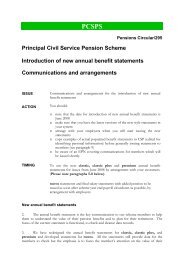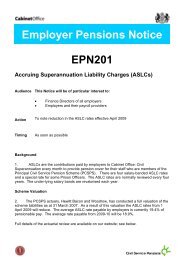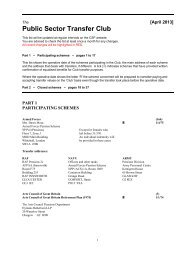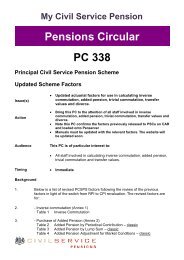Capability Reviews: Progress and Next Steps - The Civil Service
Capability Reviews: Progress and Next Steps - The Civil Service
Capability Reviews: Progress and Next Steps - The Civil Service
- No tags were found...
Create successful ePaper yourself
Turn your PDF publications into a flip-book with our unique Google optimized e-Paper software.
• Prioritisation. When asked what would make the most difference to enablingchange to happen, the most common factor identified by the SCS was ‘clearobjectives’ – ‘real prioritisation: deciding what the key changes are <strong>and</strong> reallyfollowing them through’ <strong>and</strong> ‘clear communication … about goals <strong>and</strong>mechanisms for getting there, <strong>and</strong> being very clear about individual roles’. Factorshindering change included ‘too many competing priorities’ <strong>and</strong> ‘lack of commonobjectives <strong>and</strong> prioritisation’. <strong>The</strong>re is a widespread perception within departmentsthat leaders are not setting priorities effectively enough, <strong>and</strong> this links back to thechallenge of developing strategies that are both deliverable <strong>and</strong> delivered.What is the centre doing to build capability in delivery <strong>and</strong> performance?Delivery <strong>and</strong> performance involves PMDU, HM Treasury, OGC, the Strategy Unit <strong>and</strong>Transformational Government. <strong>The</strong> heads of profession for operational delivery <strong>and</strong>policy delivery also have a key role in improving skills in this area.• Departments’ progress towards delivering the 30 new PSAs will be monitored <strong>and</strong>assessed by PMDU, which previously had a narrower focus on the PrimeMinister’s top priorities for delivery.Case study: Improving performance management in government‘Going forward, the Government has announced a new performance managementframework for the 2008–2011 CSR period. This includes a streamlined set of30 new PSAs, which set the Government’s priority outcomes for the next threeyears <strong>and</strong> span departmental boundaries, setting out a shared vision <strong>and</strong> leadingcollaboration at all levels in the delivery system. <strong>The</strong> new framework also includes:• a single Delivery Agreement for each PSA, developed in consultation withfront-line workers <strong>and</strong> the public, <strong>and</strong> published to strengthen accountability<strong>and</strong> ownership across organisational boundaries;• a key role for new Cabinet Committees which will drive performance on crossgovernmentPSAs by regularly monitoring progress <strong>and</strong> holding departments <strong>and</strong>programmes to account. <strong>The</strong> Government is also examining the scope for buildingPSAs explicitly into the performance management framework for the <strong>Civil</strong> <strong>Service</strong> –ensuring a relentless focus on PSA delivery in Whitehall;• a small basket of national, outcome-focused indicators to support each PSA,ensuring robust <strong>and</strong> transparent performance measurement alongside genuinerationalisation, with a significant reduction in the overall number of priorityindicators attached to PSAs;• targets used where appropriate to deliver improved performance <strong>and</strong>accountability; with nationally set targets reserved for a small subset of PSAindicators that require firm central direction, <strong>and</strong> far greater space for increasedlocal target setting;48 COMMON CAPABILITY GAPS: PROGRESS AND NEXT STEPS
















